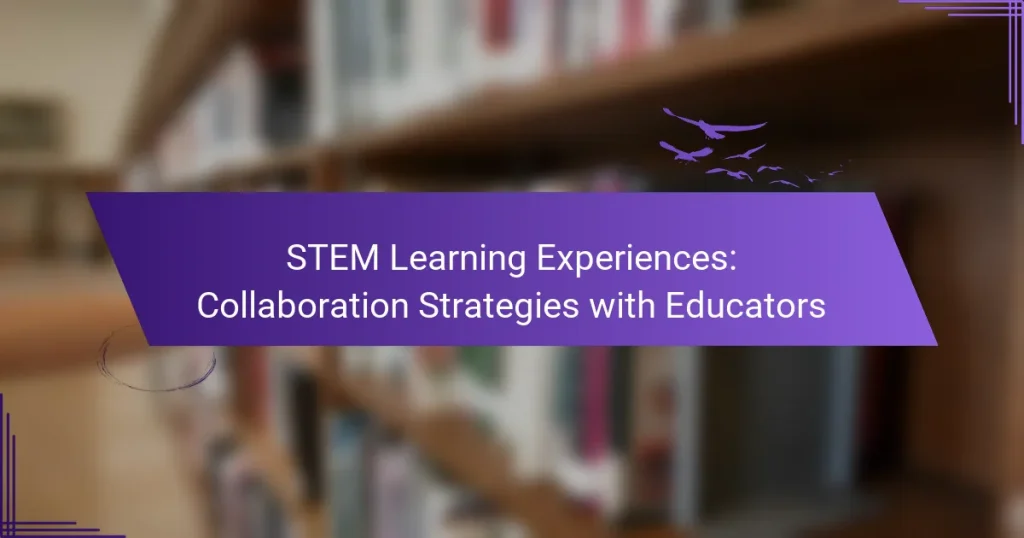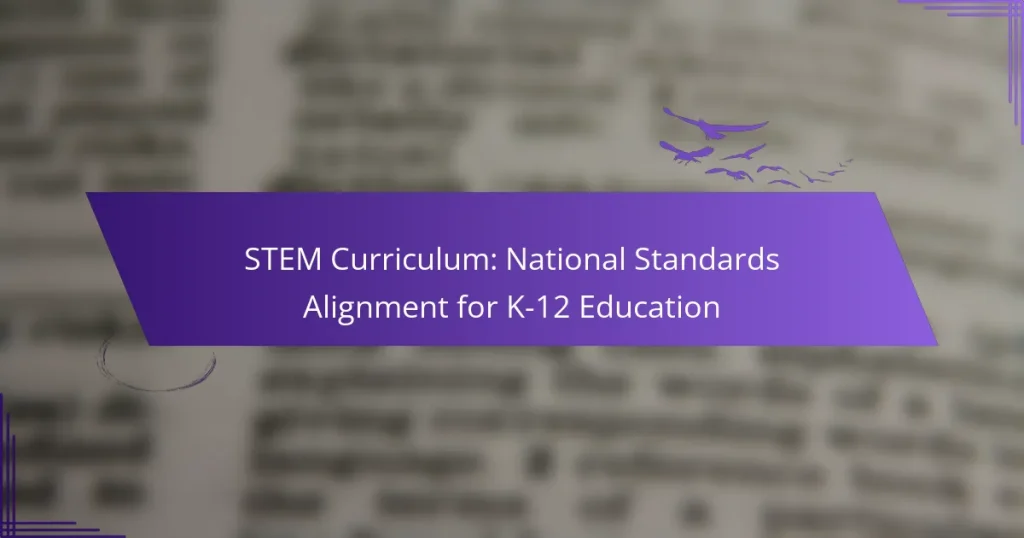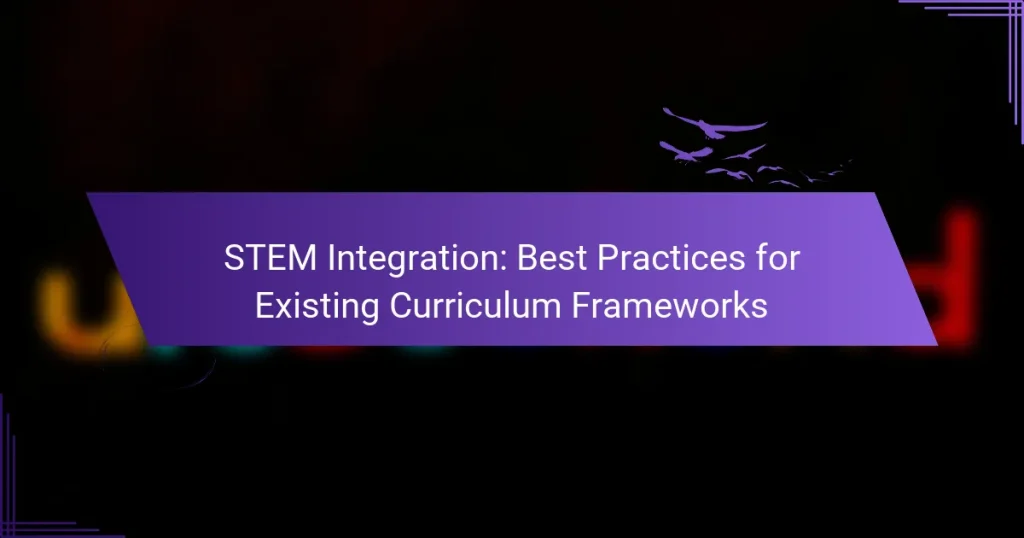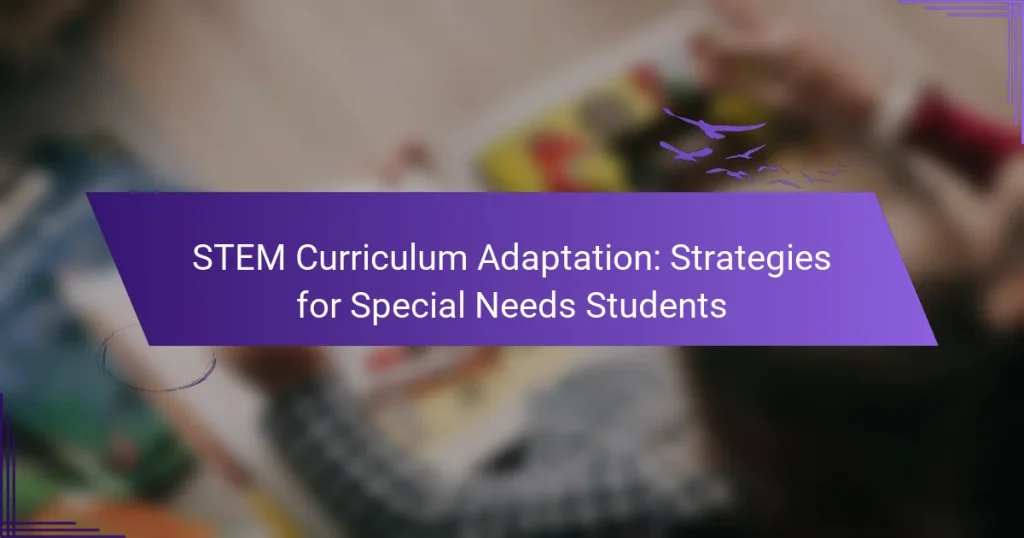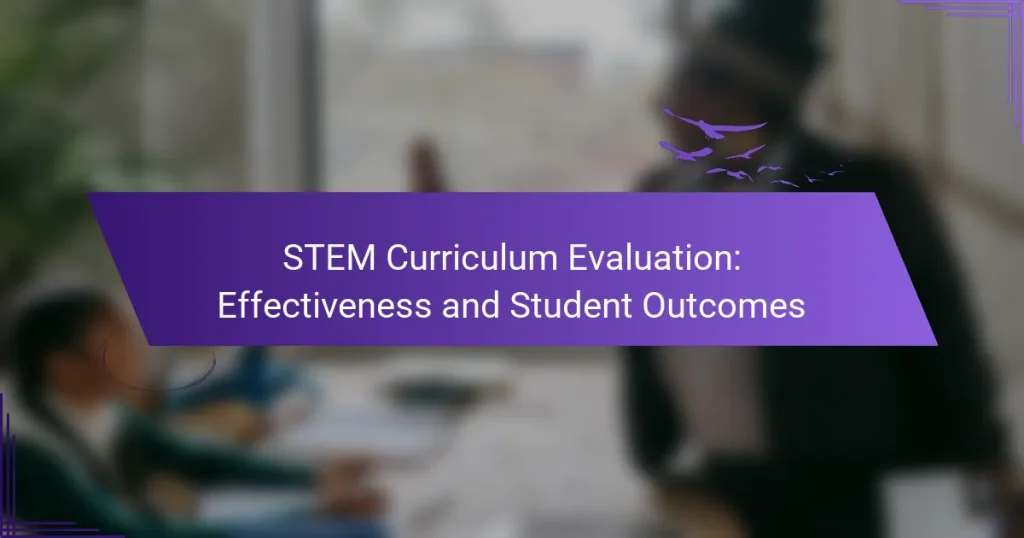Curriculum development for STEM learning is essential for creating engaging and effective educational experiences. By focusing on interactive content and aligning with educational standards, educators can foster critical thinking and problem-solving skills. Continuous collaboration with industry experts and regular feedback ensures that the curriculum remains relevant and impactful for students.
STEM Curriculum: National Standards Alignment for K-12 Education
STEM Integration: Best Practices for Existing Curriculum Frameworks
STEM Curriculum Adaptation: Strategies for Special Needs Students
STEM Units: Interdisciplinary Approaches for Middle School Learners
STEM Learning Experiences: Project-Based Methods for High School Students
STEM Curriculum Evaluation: Effectiveness and Student Outcomes
How to design effective STEM curricula for online courses?
To design effective STEM curricula for online courses, focus on engaging content that promotes critical thinking and problem-solving. Incorporate interactive elements and assessments that encourage active participation and collaboration among students.
Incorporate project-based learning
Project-based learning (PBL) immerses students in real-world challenges, enhancing their understanding of STEM concepts. By allowing students to work on projects that require research, design, and implementation, they develop practical skills and deeper knowledge.
Consider structuring projects around themes relevant to students’ interests or current events. For example, a project could involve designing a sustainable energy solution for their community, which combines science, technology, engineering, and mathematics.
Utilize interdisciplinary approaches
Interdisciplinary approaches integrate various subjects, making learning more cohesive and relevant. By connecting math, science, and technology with subjects like art or social studies, students can see the broader applications of STEM knowledge.
For instance, a unit on environmental science could include mathematical modeling of pollution data, artistic presentations of findings, and discussions on social impacts. This method fosters a more holistic understanding and encourages collaboration among students with diverse strengths.
Integrate technology tools
Integrating technology tools enhances engagement and facilitates interactive learning experiences. Use platforms that allow for simulations, virtual labs, and collaborative projects, enabling students to experiment and innovate in a digital environment.
Popular tools include coding platforms like Scratch for programming, simulation software for physics experiments, or online collaboration tools like Google Workspace. Ensure that the chosen tools align with learning objectives and are accessible to all students.
Focus on real-world applications
Highlighting real-world applications of STEM concepts makes learning more relevant and motivating. Use case studies, guest speakers from industry, or field trips (virtual or physical) to illustrate how STEM skills are used in various professions.
For example, a lesson on robotics could include a visit to a local tech company, where students can see robots in action and learn about their design and functionality. This connection to real-life scenarios can inspire students and enhance their understanding of the subject matter.
What are the best practices for STEM curriculum development?
The best practices for STEM curriculum development focus on aligning educational standards, collaborating with industry experts, and incorporating continuous feedback. These practices ensure that the curriculum remains relevant, effective, and engaging for students.
Align with educational standards
Aligning STEM curriculum with educational standards is crucial for ensuring that students meet required learning outcomes. Familiarize yourself with local and national standards, such as the Next Generation Science Standards (NGSS) in the United States or the National Curriculum in the UK. This alignment helps educators create a structured approach to teaching essential concepts.
Consider mapping out the curriculum against these standards to identify gaps and ensure comprehensive coverage of necessary skills. Regularly review and update the curriculum to reflect any changes in standards or educational priorities.
Engage with industry experts
Engaging with industry experts provides valuable insights into current trends and practices in STEM fields. Collaborate with professionals from relevant industries to ensure that the curriculum reflects real-world applications and emerging technologies. This connection can enhance the relevance of the material and inspire students.
Invite guest speakers, organize workshops, or establish partnerships with local businesses and organizations. These interactions can help students understand the practical implications of their studies and foster interest in STEM careers.
Implement continuous feedback loops
Continuous feedback loops are essential for refining and improving the STEM curriculum. Collect feedback from students, teachers, and industry partners to assess the effectiveness of the curriculum and identify areas for enhancement. This iterative process ensures that the curriculum remains dynamic and responsive to the needs of learners.
Utilize surveys, focus groups, and classroom observations to gather insights. Regularly analyze this feedback to make informed adjustments, ensuring that the curriculum evolves alongside advancements in STEM education and industry demands.
How can educators assess STEM learning outcomes?
Educators can assess STEM learning outcomes through various methods that gauge students’ understanding and application of concepts. Effective assessment strategies include formative assessments and performance-based evaluations, which provide insights into students’ progress and areas needing improvement.
Use formative assessments
Formative assessments are ongoing evaluations that help educators monitor student learning during the instructional process. Techniques such as quizzes, polls, and classroom discussions can provide immediate feedback, allowing teachers to adjust their teaching strategies accordingly.
For example, using quick exit tickets at the end of a lesson can help identify which concepts students grasped and which require further clarification. Aim to incorporate these assessments regularly, as they can significantly enhance student engagement and understanding.
Conduct performance-based evaluations
Performance-based evaluations assess students’ abilities to apply their knowledge in real-world scenarios. These evaluations often involve projects, presentations, or experiments that require critical thinking and problem-solving skills.
When designing performance tasks, ensure they align with learning objectives and provide clear criteria for success. For instance, a project that requires students to build a simple machine can effectively demonstrate their understanding of physics principles. Consider using rubrics to evaluate student performance consistently and fairly.
What resources are available for STEM curriculum development?
Numerous resources are available for STEM curriculum development, ranging from online platforms to open educational materials. These resources can enhance teaching strategies and provide diverse learning experiences for students.
Access online platforms like Coursera
Online platforms such as Coursera offer a wealth of courses specifically designed for STEM education. These courses often include video lectures, interactive quizzes, and peer discussions, making them a flexible option for educators looking to enhance their curriculum.
When utilizing Coursera, consider enrolling in courses that align with your specific teaching goals or student needs. Many courses are free to audit, while certificates can be obtained for a fee, typically ranging from $30 to $100.
Utilize open educational resources
Open educational resources (OER) provide free access to teaching materials, including textbooks, lesson plans, and multimedia content. Websites like OER Commons and OpenStax offer a variety of STEM resources that can be adapted to different educational settings.
When selecting OER, ensure that the materials are up-to-date and align with local educational standards. It’s beneficial to review user ratings and feedback to gauge the effectiveness of the resources before integrating them into your curriculum.
What are the challenges in STEM curriculum development?
STEM curriculum development faces several challenges, including meeting diverse learning needs and balancing the depth and breadth of content. These obstacles can hinder effective teaching and learning, making it essential to address them thoughtfully.
Addressing diverse learning needs
Every student has unique learning preferences and abilities, making it crucial to create a STEM curriculum that accommodates these differences. Differentiation strategies, such as tiered assignments and varied instructional methods, can help engage all learners.
Incorporating hands-on activities and collaborative projects can also cater to different learning styles. For instance, visual learners may benefit from diagrams and videos, while kinesthetic learners thrive in lab settings or through simulations.
Balancing depth and breadth of content
Finding the right balance between depth and breadth in STEM subjects is vital for effective curriculum development. Too much focus on breadth may lead to superficial understanding, while excessive depth can overwhelm students and limit exposure to essential concepts.
A practical approach is to prioritize core concepts and skills while integrating interdisciplinary connections. For example, teaching the principles of physics through real-world applications in engineering can provide both depth and context.
Regularly reviewing and updating the curriculum based on student feedback and performance can help maintain this balance. Consider using formative assessments to gauge understanding and adjust content delivery accordingly.
How to integrate equity in STEM education?
Integrating equity in STEM education involves creating an environment where all students have access to quality resources and opportunities regardless of their background. This can be achieved through inclusive practices, targeted support, and ongoing assessment of educational outcomes.
Promote inclusive teaching practices
Inclusive teaching practices ensure that all students feel valued and engaged in STEM learning. This can include using diverse teaching materials that reflect various cultures and perspectives, as well as employing different instructional strategies to cater to diverse learning styles.
For example, educators can incorporate project-based learning that allows students to work in teams, promoting collaboration and communication. Regularly seeking feedback from students about their learning experiences can also help identify areas for improvement.
Support underrepresented groups
Supporting underrepresented groups in STEM is crucial for fostering a diverse workforce. Schools and institutions can implement mentorship programs that connect students from these groups with role models in STEM fields, providing guidance and encouragement.
Additionally, offering scholarships or financial assistance can help alleviate barriers to participation. Schools should also consider outreach programs that engage communities and raise awareness about STEM opportunities, ensuring that all students have the chance to pursue their interests in these fields.
What emerging trends are shaping STEM education?
Emerging trends in STEM education include the integration of technology, project-based learning, and a focus on real-world applications. These trends aim to enhance student engagement and prepare learners for future careers in science, technology, engineering, and mathematics.
Integration of Technology in STEM Learning
The integration of technology in STEM education is transforming how students learn and interact with content. Tools such as coding platforms, simulation software, and virtual labs allow students to experiment and visualize complex concepts. For instance, using augmented reality can help students understand intricate biological processes or engineering designs.
Educators should consider incorporating various technological tools to cater to different learning styles. However, it’s essential to ensure that technology complements the curriculum rather than distracts from it. A balanced approach that combines hands-on activities with digital resources can yield the best results.
Project-Based Learning Approaches
Project-based learning (PBL) encourages students to engage in real-world challenges, fostering critical thinking and collaboration. In PBL, students work on projects that require them to apply STEM concepts to solve problems, which enhances their understanding and retention of the material. For example, a project might involve designing a sustainable energy solution for their school.
When implementing PBL, educators should define clear objectives and provide ongoing support. It’s crucial to assess both the process and the final product, ensuring students receive constructive feedback throughout the project. This method not only builds knowledge but also develops essential skills like teamwork and communication.
Focus on Real-World Applications
Focusing on real-world applications in STEM education helps students see the relevance of their studies. By connecting lessons to current events, industry practices, or community issues, educators can increase student motivation and interest. For instance, discussing climate change can lead to projects on renewable energy sources.
To effectively incorporate real-world applications, teachers should collaborate with local businesses or organizations. This partnership can provide students with insights into professional practices and potential career paths. Additionally, integrating field trips or guest speakers can enhance the learning experience and inspire students.
